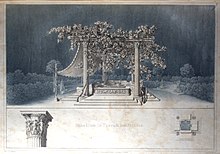

The stibadium (pl.: stibadia)[1] is a later form of the ancient Roman lectus triclinaris, the reclining seat used by diners in the triclinium. Originally, the lecti were arranged in a group of three in a semi-circle. The stibadium was a single semi-circular couch, fitting up to a dozen people, which replaced the triple group of lecti in the dining-room, frequently in alcoves around the centre of the room. In large Roman villas stibadia often became very elaborate.
This furniture is also called sigma.[2] This name comes from the lunate sigma (upper case C, lower case ϲ) which resembles, but is not at all related to, the Latin letter C and was used in Eastern forms of Greek writing and in the Middle Ages.
The stibadium was originally an outdoor seat but was introduced indoors in the 2nd and 3rd centuries AD because the shape was more convenient for entertaining and as triclinia became larger and more elaborate.

Films about ancient Roman convivia often feature a stibadium rather than a lectus.
Examples
[edit]Roman villas with stibadia include the:
- Roman villa of Faragola
- Pliny's villa "in Tuscis"[3]
- Villa El Ruedo (Spain)
- Nymphaeum Utere Felix (Carthage)
See also
[edit]Notes
[edit]- ^ Pliny Epistles 5, 6, 36
- ^ The Roman banquet: images of conviviality, Katherine Dunbabin, 2003, p. 166
- ^ Pliny LII. To Domitius Apollinaris https://www.bartleby.com/9/4/1052.html
External links
[edit]![]() Media related to Stibadia at Wikimedia Commons
Media related to Stibadia at Wikimedia Commons
Well, that’s interesting to know that Psilotum nudum are known as whisk ferns. Psilotum nudum is the commoner species of the two. While the P. flaccidum is a rare species and is found in the tropical islands. Both the species are usually epiphytic in habit and grow upon tree ferns. These species may also be terrestrial and grow in humus or in the crevices of the rocks.
View the detailed Guide of Psilotum nudum: Detailed Study Of Psilotum Nudum (Whisk Fern), Classification, Anatomy, Reproduction